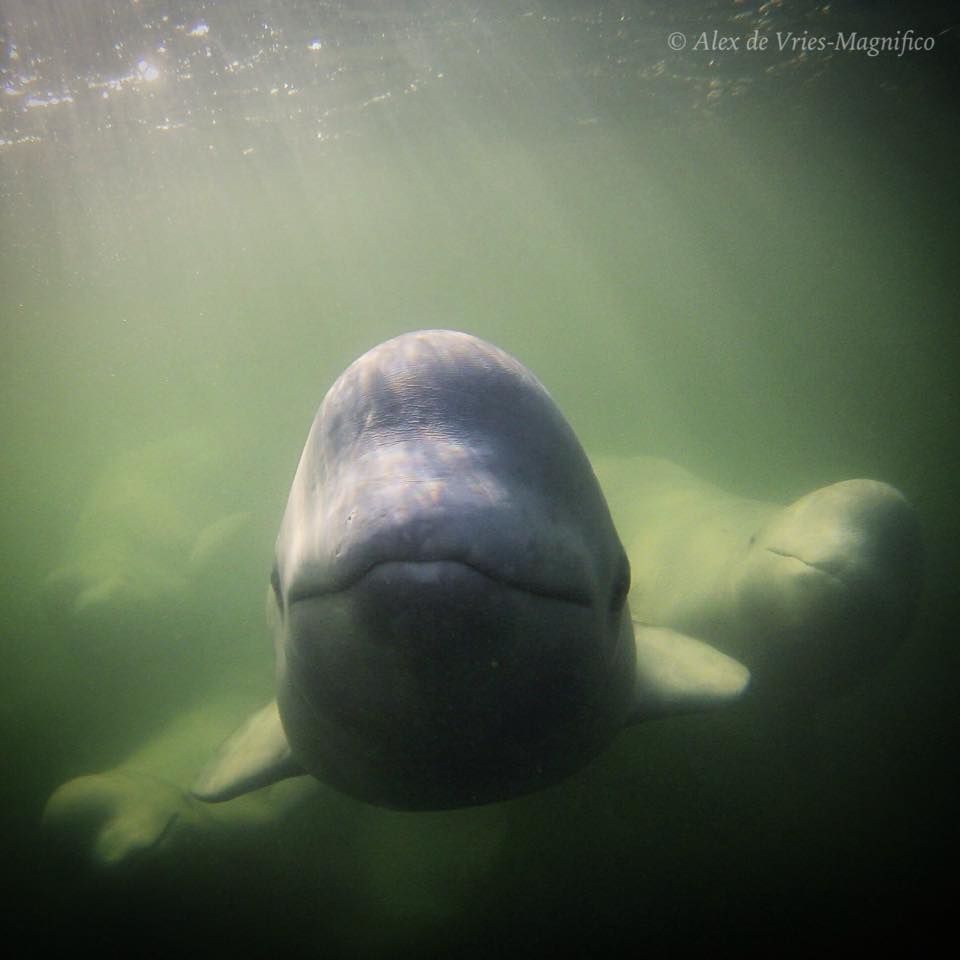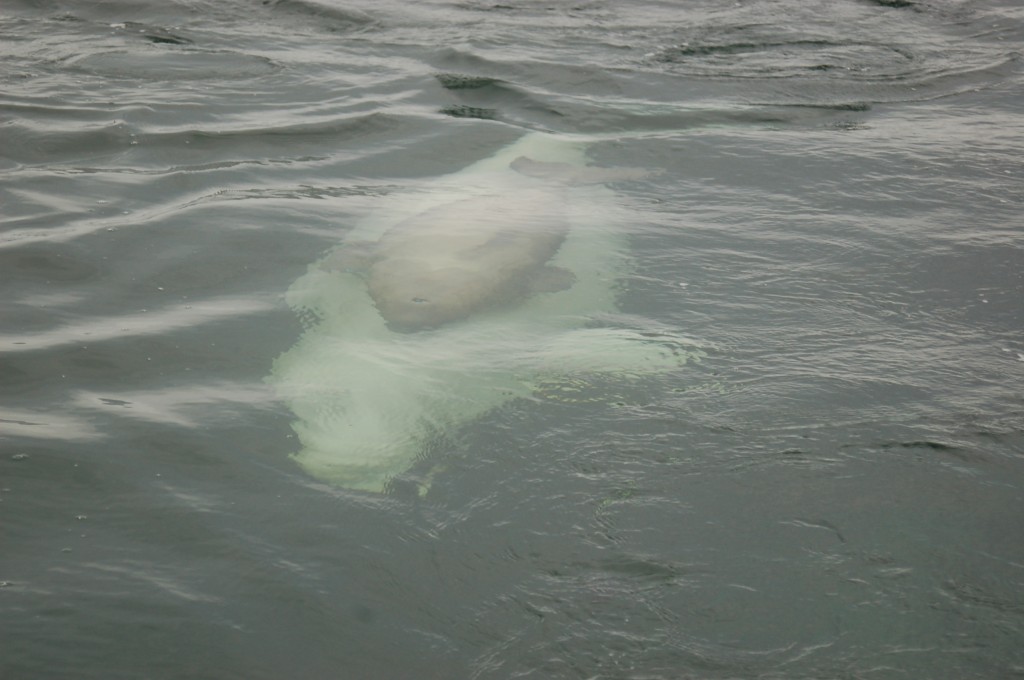– Physical Characteristics
The beluga is a small toothed whale, weighing between 1,100 and 3,300 fifteen feet in length; males of this species are larger than the females. The beluga’s body is stout and has a small, blunt head with a small beak, tiny eyes, and a thick layer of blubber. It also has a rounded melon on its head, which is thought by some to focus echolocation tones. The melon can also be used as an indicator of health (poorly nourished belugas have low, flat melons, while well fed individuals have round melons) and of emotional state – aggressive individuals raise their melons forward.

Beluga up close and personal with snorkelers in the Churchill River. Alex De Vries – Magnifico photo.
The beluga has one blowhole, does not have a dorsal fin, and its tail is strongly forked. In its mouth, 38 spoon-shaped teeth are present. In addition, unlike most other cetaceans, the beluga’s seven neck vertebrae are not fused, giving it a flexible, well-defined neck. Belugas are well insulated, which allows them to stay warm in the icy Arctic waters – they have an insulating layer of blubber that is usually four to six inches thick, which varies with the season and the water temperature.
The most striking characteristic of the beluga whale is its ghost-white coloring. In fact, the name beluga comes from the Russian word bieluii, which means ‘white.’ While belugas are also commonly called the ‘white whales,’ they are not the same animal as the white whale described by Herman Melville in Moby Dick (that was an albino sperm whale). As a newborn, the beluga is not white at all – it is grayish-brown in color. As it grows older, it turns mottled and yellowish, and then a pure white.

A beluga whale popping out from the Churchill River near the mouth where visibility is amazing. Steve Selden photo.
– Habitat
There is only one species of the beluga. It is circumpolar in distribution and lives among the icebergs and floating ice of the Arctic regions. In July, it ascends some of the northern rivers to pursue salmon that are on their way to the spawning grounds. The beluga travels in schools of a few individuals up to the thousands; the large schools, however, are seldom seen today. The pods we will see off of the port of Churchill can number in the hundreds.
The beluga is widely, though not uniformly, distributed throughout the seasonally ice-covered Arctic and sub-Arctic waters off the coasts of North America, Asia, Europe, Svalbard, and Greenland. Belugas are usually found in water temperatures below 59°F, but stragglers may wander further afield. Southernmost sightings of the species have been in New Jersey and Puget Sound, on the east and west coasts of the U.S., and off the coast of Sakhalin Island in the Sea of Okhotsk. These animals may winter on the front of the seasonal ice pack or in polynyas – shifting areas of open water within the ice.
– Feeding Habits
Belugas eat a wide variety of prey, more diverse than most cetaceans. Many fish species, such as herring, cod, and salmon, as well as invertebrates, such as octopus, squid, crab, and snails, are taken. In addition, the stomachs of belugas have been found to contain bottom-dwelling organisms.
An adult beluga will eat about two to three percent of its body weight (about 50 pounds) per day. It is thought that belugas use echolocation to aid in the search for food. Their feeding dives last anywhere from three to five minutes, although one individual was seen remaining underwater for twenty minutes and diving to a depth of 2,123 feet.
– Beluga Behavior
Beluga whales are very social animals, and most parts of the year, they congregate in social units, or pods, of about 10 individuals led by a single large male. A pod will hunt and migrate as a group, and during migration or periods of great food abundance, groups of up to 10,000 belugas have been reported. Wintering sites can be either north or south of summering sites, and either closer to or farther from shore. Prey distribution and pack ice are two factors in determining seasonal movements.
Belugas are relatively slow swimmers, with speeds of about two to six miles per hour. However, they are capable of short bursts of speed up to fourteen miles per hour for about 15 minutes. In the spring, as leads form in the pack ice and the ice retreats from the coast, some belugas migrate to relatively warm estuarine waters. The beluga is well adapted to living close to shore; it can swim in very shallow water and maneuver in depths barely covering its body. If stranded, it can often survive until the next high tide.
The beluga is one of the most vocal of the toothed whales. It has a large repertoire of clicks, moos, squeaks, trills, and twitters, which can be heard above and below the surface. Many of the noises made by the beluga are audible to humans. In fact, the beluga was nicknamed the ‘sea canary’ by the whalers of old, who could hear its squeaks and cries through the wooden hulls of their boats.
They are also able to show a wide array of facial expressions with the aid of their flexible melon and mouth; they may appear to smile, frown, or whistle. There appears to be a high level of communication between pod members, and while facial expressions may be a form of communication, they are mainly related to sound production. Belugas may also have the most versatile and sophisticated sonar system of any cetacean.
– Reproduction
One young per birth is the rule for the beluga; females typically give birth every two to three years. Gestation lasts about one year. Calving occurs between April and September, and the young weigh about 154 pounds at birth.

A baby calf beluga swimming in his mother’s slipstream to stay close. Steve Selden photo.
One young per birth is the rule for the beluga; females typically give birth every two to three years. Gestation lasts about one year. Calving occurs between April and September, and the young weigh about 154 pounds at birth.
When born, the calves are dark brown or black in color. They reach a blue stage between one and two years of age, and then exist in a lighter yellow phase until they reach sexual maturity, when the white color typical of this species is achieved. Calves are born with less than an inch of blubber, but they gain weight quickly while nursing on rich milk, ranging from 15 to 40 percent in fat content. Beluga young are weaned between one and a half and two years of age.

